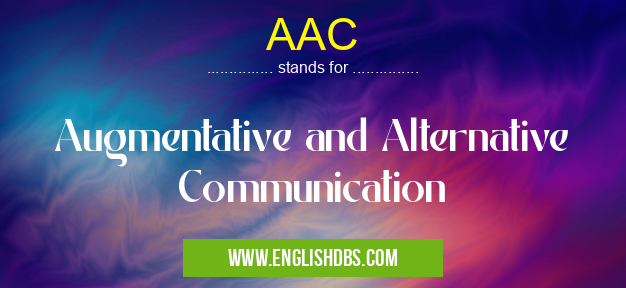What does AAC mean in LAW & LEGAL
Augmentative and Alternative Communication (AAC) is an innovative way for patients and healthcare professionals to communicate effectively. AAC allows for efficient use of technology to help individuals with speech or physical impairments, such as those with autism, multiple sclerosis, cerebral palsy and traumatic brain injury, improve communication skills.

AAC meaning in Law & Legal in Governmental
AAC mostly used in an acronym Law & Legal in Category Governmental that means Augmentative and Alternative Communication
Shorthand: AAC,
Full Form: Augmentative and Alternative Communication
For more information of "Augmentative and Alternative Communication", see the section below.
Essential Questions and Answers on Augmentative and Alternative Communication in "GOVERNMENTAL»LAW"
What is AAC?
AAC is an abbreviation for Augmentative and Alternative Communication. It is a type of assistive technology that helps people who have difficulty communicating verbally by providing different methods of communication such as symbols, pictures, electronic devices, and more.
Who uses AAC?
AAC can be used by a variety of people including those with cerebral palsy, autism spectrum disorder, traumatic brain injury, Parkinson's Disease and more. It is also used by those who may have a short-term need such as after a stroke or following surgery.
How does AAC work?
Depending on the individual's needs and abilities, AAC can range from low tech (manual communication boards) to high tech (computer voice output systems). Low tech systems include photo albums or communication books which contain images of frequently used words and phrases that the communicator can point to in order to convey their message. High tech systems include computerized speech generating devices or apps that allow users to type in words/phrases in order for the device to speak them aloud.
What are the benefits of using AAC? A4: The primary benefit of using AAC is that it helps facilitate communication between individuals who may not be able to communicate effectively otherwise. This type of communication can help users express their wants, needs and thoughts more clearly; obtain social interaction; increase independence; boost self-esteem; reduce frustration due to limited speech capabilities; increase educational opportunities; maintain relationships; empower participation at home, school and work spaces; develop language skills; improve attention span; provide diverse sources of information/entertainment; etc. Q5: Are there any drawbacks when using AAC?
The primary benefit of using AAC is that it helps facilitate communication between individuals who may not be able to communicate effectively otherwise. This type of communication can help users express their wants, needs and thoughts more clearly; obtain social interaction; increase independence; boost self-esteem; reduce frustration due to limited speech capabilities; increase educational opportunities; maintain relationships; empower participation at home, school and work spaces; develop language skills; improve attention span; provide diverse sources of information/entertainment; etc. Q5: Are there any drawbacks when using AAC? A5: The primary drawback with using some forms of AAC technology is cost — they tend to be quite expensive — however there are several organizations available that offer financial assistance towards these types of devices or apps. Additionally there may be some difficulty in obtaining trained professionals who are familiar with setting up the system accurately as well as teaching others how to use it properly. Lastly there may also be an issue when it comes to finding compatible accessories for the system if needed (e.g., external speakers).
Final Words:
Overall Augmentative & Alternative Communication (AAC) provides many benefits for those unable to communicate effectively through traditional means - enabling individuals access to increased independence & improved quality of life through providing easier access & improved understanding between speaker & listener alike.
AAC also stands for: |
|
| All stands for AAC |
